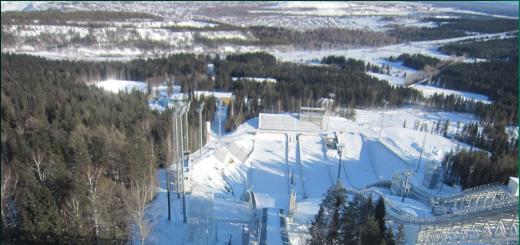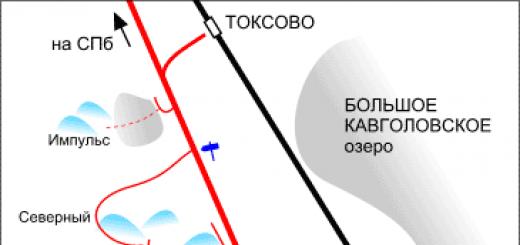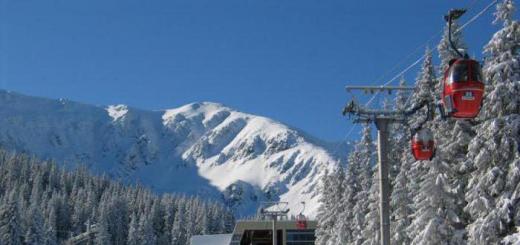The longitudinal stability of the vessel is significantly higher than the lateral stability, therefore, for the safety of navigation, it is most important to ensure the proper lateral stability.
- Depending on the value of the inclination, stability is distinguished at small angles of inclination ( initial stability) and stability at large angles of inclination.
- Depending on the nature acting forces distinguish between static and dynamic stability.
Initial transverse stability
Initial lateral stability. System of forces acting on a ship
When heeling, stability is considered as initial at angles up to 10-15 °. Within these limits, the restoring force is proportional to the roll angle and can be determined using simple linear relationships.
It is assumed that deviations from the equilibrium position are caused by external forces that do not change either the weight of the vessel or the position of its center of gravity (CG). Then the immersed volume does not change in magnitude, but changes in shape. Equal-volume inclinations correspond to equal-volume waterlines, cutting off the submerged volumes of the hull of equal size. The line of intersection of the planes of the waterlines is called the axis of inclination, which at equal-volume inclinations passes through the center of gravity of the area of the waterline. With transverse inclinations, it lies in the diametrical plane.
Free surfaces
All the cases discussed above assume that the center of gravity of the vessel is stationary, that is, there are no weights that move when inclined. But when there are such loads, their effect on stability is much greater than the rest.
Typical cases are liquid cargo (fuel, oil, ballast and boiler water) in tanks that are partially filled, that is, with free surfaces. Such weights are capable of overflowing when tilted. If the liquid cargo fills the tank completely, it is equivalent to a solid fixed cargo.
Influence of the free surface on stability
If the liquid does not fill the tank completely, i.e. has a free surface that always occupies a horizontal position, then when the vessel is tilted at an angle θ the liquid pours in the direction of inclination. The free surface will take the same angle relative to the waterline.
Levels of liquid cargo cut off equal volumes of tanks, i.e. they are like equal-volume waterlines. Therefore, the moment caused by the overflow of liquid cargo when heeling δm θ, can be represented similarly to the moment of form stability m f, only δm θ the opposite m f by sign:
δm θ = - γ and i x θ,Where i x- the moment of inertia of the free surface area of the liquid cargo relative to the longitudinal axis passing through the center of gravity of this area, γ w- specific gravity of liquid cargo
Then the restoring moment in the presence of a liquid cargo with a free surface:
m θ1 = m θ + δm θ = Phθ - γ w i x θ = P (h - γ w i x / γV) θ = Ph 1 θ,Where h- transverse metacentric height in the absence of transfusion, h 1 = h - γ and i x / γV is the actual transverse metacentric height.
Influence of overflowing weight gives correction for lateral metacentric height δ h = - γ w i x / γV
The densities of water and liquid cargo are relatively stable, that is, the main influence on the correction is provided by the shape of the free surface, more precisely, its moment of inertia. This means that the lateral stability is mainly influenced by the width, and the longitudinal length of the free surface.
The physical meaning of the negative value of the correction is that the presence of free surfaces is always reduces
In contrast to the static one, the dynamic action of forces and moments imparts significant angular velocities and accelerations to the vessel. Therefore, their influence is considered in energies, more precisely in the form of the work of forces and moments, and not in the efforts themselves. In this case, the kinetic energy theorem is used, according to which the increment of the kinetic energy of the inclination of the vessel is equal to the work of the forces acting on it.
When a heeling moment is applied to the ship m cr constant in magnitude, it receives a positive acceleration, with which it begins to roll. As the inclination increases, the restoring moment increases, but first, up to the angle θ ct at which m cr = m θ, it will be less heeling. Upon reaching the angle of static equilibrium θ ct, the kinetic energy of rotational motion will be maximum. Therefore, the vessel will not remain in the equilibrium position, but due to the kinetic energy will heel further, but more slowly, since the restoring moment is greater than the heeling moment. The previously accumulated kinetic energy is extinguished by the excess work of the restoring torque. As soon as the amount of this work is sufficient to completely dissipate the kinetic energy, the angular velocity will become equal to zero and the ship will stop heeling.
The largest angle of inclination that the boat receives from the dynamic moment is called the dynamic bank angle. θ din... In contrast, the roll angle with which the ship will sail under the influence of the same moment (by the condition m cr = m θ) is called the static roll angle θ st.
Referring to the static stability diagram, the work is expressed by the area under the restoring moment curve m in... Accordingly, the dynamic roll angle θ din can be determined from the equality of areas OAB and BCD corresponding to the excess work of the restoring torque. Analytically, the same work is calculated as:
in the range from 0 to θ din.
Reaching the dynamic roll angle θ din, the ship does not come to equilibrium, and under the influence of the excess restoring moment begins to accelerate to straighten. In the absence of water resistance, the vessel would enter into continuous oscillations around the equilibrium position when heeling θ st Maritime vocabulary - Refrigerated vessel Ivory Tirupati initial stability is negative Stability the ability of a floating vehicle to withstand external forces causing it to roll or trim and return to a state of equilibrium after the end of the disturbing ... ... Wikipedia
A ship, the hull of which, when moving, rises above the water under the action of the lifting force created by the wings submerged in the water. The patent for the shipbuilding was issued in Russia in 1891, but these ships began to be used from the second half of the 20th century ... ... Great Soviet Encyclopedia
An all-terrain vehicle capable of moving both on land and on water. The amphibious car has an increased volume of a pressurized body, which is sometimes supplemented with hinged floats for better buoyancy. Moving on water ... ... Encyclopedia of technology
- (Malay) type of sailing vessel, lateral stability against horn is provided by an outrigger float, attached. to the main. the body with transverse beams. The ship is like a sailing catamaran. In ancient times, P. served as a means of communication on the Pacific Islands ... ... Big Encyclopedic Polytechnic Dictionary
amphibian Encyclopedia "Aviation"
amphibian- (from the Greek amphíbios - leading a dual lifestyle) - a seaplane equipped with a land landing gear and capable of being based both on the water surface and on land airfields. The most common are A. boats. Takeoff from the water, ... ... Encyclopedia "Aviation"
METACENTER
METACENTER
(Metacenter) - the point of intersection of the normals to the planes of the ship's waterlines when inclined, drawn through the centers of gravity of the underwater volumes (centers of magnitude). Distinguish transverse M. - when the vessel is inclined about its longitudinal axis and longitudinal M. - when inclined about the transverse axis. For any vessel (both surface and submarine), M. must be above the center of gravity.
Samoilov K.I. Marine dictionary. - M.-L .: State Naval Publishing House of the NKVMF of the USSR, 1941
Metacenter
the center of curvature of the trajectory of displacement of the center of magnitude when the ship (floating body) is inclined. When leaning from side to side, the position of the metacentre differs from the position of the metacentre when leaning from bow to stern. The transverse and longitudinal metacentres are distinguished accordingly. If the center of gravity of the vessel lies below the metacentre (primarily transverse), then when the vessel is tilted, a pair of forces will act on it, returning it to its original position. Therefore, the metacentre should be considered as the limit to which the center of gravity of the vessel can be raised (for example, when spending supplies, unloading), without depriving the latter of positive stability.
EdwART. Explanatory Naval Dictionary, 2010
Synonyms:
See what "METACENTER" is in other dictionaries:
Metacenter ... Spelling dictionary-reference
- (Greek, from meta, and kentron center). The center of gravity in stable equilibrium, which is usually outside the present center. Dictionary of foreign words included in the Russian language. Chudinov AN, 1910. METACENTER Greek., From meta, and kentron, center ... Dictionary of foreign words of the Russian language
Point, from the position to the swarm, the stability of the balance (stability) of the floating body depends. In equilibrium on a floating body, in addition to gravity P applied at the center of gravity (CG) of the body (Fig.), Buoyant force A also acts, the line of action to ... ... Physical encyclopedia
The point on the position of which the stability of the balance of a floating body depends. For a body with a longitudinal plane of symmetry, the metacentre is the point of intersection with this plane of the resultant forces of fluid pressure on the body ... Big Encyclopedic Dictionary
METACENTER, metacentre, husband. (from the Greek meta outside, for and lat. centrum center) (physical). The point of intersection of the vertical line passing through the center of gravity of the floating body (vessel) with the plane of the dive line (with the waterline). Ushakov's explanatory dictionary ... Ushakov's Explanatory Dictionary
Male, fur center of gravity, outside the center of volume, size; | pestilence the point of mutual intersection of the plumb line passing through the center of gravity of the vessel and the direction of the lateral water pressure when the ship is tilted; the ship must always be so loaded that the center ... ... Dahl's Explanatory Dictionary
Noun., Number of synonyms: 1 point (100) ASIS synonym dictionary. V.N. Trishin. 2013 ... Synonym dictionary
Lateral inclination of a floating vessel. The metacenter is denoted M. The center of magnitude is denoted by B Metacenter (from the Greek μετα through and Latin centrum center) the center of curvature of the trajectory ... Wikipedia
LECTURE No. 4
General stability provisions. Stability at low inclinations. Metacentre, metacentric radius, metacentric height. Metacentric stability formulas. Determination of the parameters of landing and stability when moving goods on board. Influence on stability of unsecured and liquid cargo.
Inclining experience.
Stability is called the ability of a ship, brought out of the position of normal equilibrium by any external forces, to return to its original position after the cessation of the action of these forces. External forces that can bring the ship out of normal equilibrium include: wind, waves, movement of goods and people, as well as centrifugal forces and moments that occur when the ship turns. The navigator is obliged to know the peculiarities of his vessel and correctly assess the factors affecting its stability.
Distinguish between transverse and longitudinal stability... Lateral stability of the vessel is characterized by the relative position of the center of gravity G and the center of magnitude FROM. Consider lateral stability.
If the vessel is heeled on one side at a small angle (5-10 °) (Fig. 1), the CV will move from point C to point. Accordingly, the support force acting perpendicular to the surface will intersect the diametrical plane (DP) at the point M.
The point of intersection of the ship's DP with the continuation of the direction of the support force during roll is called initial metacentre M... Distance from the point of application of the supporting force FROM before the initial metacentre is called metacentric radius .

Fig. 1 - C tatic forces acting on a ship at low heels
Distance from the initial metacentre M to the center of gravity G called initial metacentric height
 .
.
The initial metacentric height characterizes the stability at low inclinations of the vessel, measured in meters and is a criterion for the initial stability of the vessel. As a rule, the initial metacentric height of motorboats and boats is considered good if it is greater than 0.5 m, for some ships it is permissible less, but not less than 0.35 m.
A sharp inclination causes a lateral roll of the vessel and the stopwatch measures the period of free roll, that is, the time of full swing from one extreme position to another and back. The transverse metacentric height of the vessel is determined by the formula:
 ,
m
,
m
Where IN- the width of the vessel, m; T- rolling period, sec.
To evaluate the results obtained, the curve in Fig. 2 plotted according to data from y  suburban designed boats.
suburban designed boats.
Ri. 2 - W dependence of the initial metacentric height on the length of the ship
If the initial metacentric height  , determined by the above formula, will be below the shaded strip, it means that the vessel will have a smooth pitching, but insufficient initial stability, and navigation on it can be dangerous. If the metacentre is located above the shaded strip, the vessel will be characterized by rapid (sharp) roll, but increased stability, and therefore, such a vessel is more seaworthy, but the habitability on it is unsatisfactory. The optimal values will be those that fall within the area of the shaded strip.
, determined by the above formula, will be below the shaded strip, it means that the vessel will have a smooth pitching, but insufficient initial stability, and navigation on it can be dangerous. If the metacentre is located above the shaded strip, the vessel will be characterized by rapid (sharp) roll, but increased stability, and therefore, such a vessel is more seaworthy, but the habitability on it is unsatisfactory. The optimal values will be those that fall within the area of the shaded strip.
The roll of the vessel to one of the sides is measured by the angle  between the new tilted position of the center line with a vertical line.
between the new tilted position of the center line with a vertical line.
The inclined side will displace water more than the opposite side, and the CV will shift towards the bank. Then the resultant forces of support and weight will be unbalanced, forming a pair of forces with a shoulder equal to
 .
.
The repetitive action of the forces of weight and support is measured by the restoring moment:
 .
.
Where D- buoyancy force equal to the weight of the vessel; l- stability shoulder.
This formula is called the metacentric stability formula and is valid only for small heel angles at which the metacentric center can be considered constant. At large roll angles, the metacentre is not constant, as a result of which the linear relationship between the restoring moment and the roll angles is violated.
Small (  ) and big (
) and big (  ) metacentric radii can be calculated using the formulas of Professor A.P. Fan-der-Fleet:
) metacentric radii can be calculated using the formulas of Professor A.P. Fan-der-Fleet:
 ;
;
 .
.
By the relative position of the cargo on the ship, the boatmaster can always find the most favorable value of the metacentric height, at which the ship will be sufficiently stable and less subject to rolling.
The heeling moment is the product of the weight of the cargo moved across the vessel by the shoulder equal to the distance of movement. If a person weighing 75 kg, sitting on the bank will move across the vessel by 0.5 m, then the heeling moment will be equal to 75 * 0.5 = 37.5 kg / m
To change the moment that heels the vessel by 10 °, it is necessary to load the vessel to full displacement, completely symmetrically relative to the centreline plane. The loading of the vessel should be checked by the draft measured from both sides. The inclinometer is installed strictly perpendicular to the DP so that it shows 0 °.
After that, it is necessary to move loads (for example, people) at pre-marked distances until the inclinometer shows 10 °. The experiment for verification should be carried out as follows: bank the vessel on one side and then on the other side. Knowing the fastening moments of the vessel heeling at different (up to the maximum possible) angles, it is possible to construct a diagram of the static stability (Fig. 3), which will allow us to assess the stability of the vessel.

Fig. 3 - Static stability diagram
Stability can be increased by increasing the width of the vessel, lowering the CG, and arranging stern boules.
If the ship's CG is located below the CG, then the ship is considered very stable, since the support force during roll does not change in magnitude and direction, but the point of its application shifts towards the inclination of the ship (Fig. 4, a). Therefore, when heeling, a pair of forces is formed with a positive restoring moment, tending to return the ship to its normal vertical position on a straight keel. It is easy to see that h> 0, with a metacentric height of 0. This is typical for yachts with a heavy keel and not typical for larger vessels with a conventional hull arrangement.
If the CG is located above the CW, there are three possible stability cases, which the skipper should be familiar with.
1st case of stability
Metacentric height h> 0. If the center of gravity is located above the center of magnitude, then when the vessel is in an inclined position, the line of action of the supporting force intersects the diametrical plane above the center of gravity (Fig. 4, b).

Figure 4 - Case of a ship in stability
In this case, a pair of forces with a positive restoring moment is also formed. This is typical of most ships of the normal shape. Stability in this case depends on the body and the position of the center of gravity in height. When heeling, the heeling side enters the water and creates additional buoyancy that tends to level the boat. However, when a vessel is heeled with liquid and bulk cargo capable of moving towards the bank, the center of gravity will also shift towards the bank. If the center of gravity while heeling moves beyond the plumb line connecting the center of magnitude with the metacentre, the vessel will capsize.
2nd case of unstable vessel with indifferent equilibrium
Metacentric height h= 0. If the CG lies above the CG, then during a roll, the line of action of the support force passes through the CG MG = 0 (Fig. 5).

Figure 5 - The case of an unstable vessel with indifferent equilibrium
In this case, the CW is always located on the same vertical with the CG, so there is no recovering pair of forces. Without the influence of external forces, the ship cannot return to a straight position. In this case, it is especially dangerous and completely unacceptable to transport liquid and bulk cargo on the ship: with the slightest roll, the ship will turn over. This is typical of boats with a round frame.
3rd case of an unstable vessel with unstable equilibrium
Metacentric height h<0. ЦТ расположен выше ЦВ, а в наклонном положении судна линия действия силы поддержания пересекает след диаметральной плоскости ниже ЦТ (рис. 6). Сила тяжести и сила поддержания при малейшем крене образуют пару сил с отрицательным восстанавливающим моментом и судно опрокидывается.

Fig. 6 - C ray an unstable vessel in an unstable equilibrium
The analyzed cases show that the vessel is stable if the metacentre is located above the CG of the vessel. The lower the CG descends, the more stable the vessel is. In practice, this is achieved by placing cargo not on the deck, but in the lower rooms and holds.
Due to the influence of external forces on the vessel, as well as as a result of insufficiently strong fastening of the cargo, it is possible to move it on the vessel. Let us consider the influence of this factor on the change in the parameters of the ship's landing and its stability.
Vertical movement of the load.

Fig. 1 - The influence of vertical movement of the load on the change in metacentric height
Determine the change in the ship's landing and stability caused by the movement of a small cargo  in the vertical direction (Fig. 1) from the point
in the vertical direction (Fig. 1) from the point  exactly
exactly  ... Since the mass of the cargo does not change, the displacement of the vessel remains unchanged. Therefore, the first equilibrium condition is met:
... Since the mass of the cargo does not change, the displacement of the vessel remains unchanged. Therefore, the first equilibrium condition is met:  ... It is known from theoretical mechanics that when one of the bodies moves, the CG of the entire system moves in the same direction. Therefore, the ship's CG
... It is known from theoretical mechanics that when one of the bodies moves, the CG of the entire system moves in the same direction. Therefore, the ship's CG  will move to point
will move to point  , and the vertical itself will pass, as before, through the center of magnitude
, and the vertical itself will pass, as before, through the center of magnitude  .
.
The second equilibrium condition will be met:  .
.
Since in our case both equilibrium conditions are met, we can conclude: with vertical movement of cargo, the vessel does not change its equilibrium position.
Consider the change in the initial lateral stability. Since the shapes of the volume of the ship's hull immersed in water and the area of the waterline have not changed, the position of the center of the value  and the transverse metacentre when moving the load vertically remains unchanged. Only the ship's CG moves, which will result in a decrease in the metacentric height
and the transverse metacentre when moving the load vertically remains unchanged. Only the ship's CG moves, which will result in a decrease in the metacentric height  , as well as
, as well as  from where
from where  where
where  - the weight of the transported cargo, kN;
- the weight of the transported cargo, kN;
 - the distance the CG of the cargo has moved in the vertical direction, m.
- the distance the CG of the cargo has moved in the vertical direction, m.
Stability is one of the most important seaworthiness properties of a ship, which is associated with extremely important issues related to the safety of navigation. Loss of stability almost always means the death of the vessel and very often the death of the crew. Unlike changes in other seaworthiness, the decrease in stability does not manifest itself in a visible way, and the ship's crew, as a rule, does not suspect about the impending danger until the last seconds before capsizing. Therefore, the greatest attention should be paid to the study of this section of the ship theory.
In order for a vessel to float in a given equilibrium position relative to the surface of the water, it must not only satisfy the conditions of equilibrium, but also be able to resist external forces trying to bring it out of its equilibrium position, and after the cessation of the action of these forces, it must return to its original position. Therefore, the balance of the ship must be stable, or, in other words, the ship must have positive stability.
Thus, stability is the ability of a vessel, brought out of equilibrium by external forces, to return to its original equilibrium position after the cessation of the action of these forces.
The stability of the vessel is related to its balance, which is the characteristic of the latter. If the equilibrium of the ship is stable, then the ship has positive stability; if its balance is indifferent, then the ship has zero stability, and, finally, if the balance of the ship is unstable, then it has negative stability.
Tanker Captain Shiryaev
In this chapter, the transverse inclinations of the vessel in the plane of the midship frame will be considered.
Stability at transverse inclinations, i.e., when a roll occurs, is called transverse. Depending on the angle of inclination of the vessel, the lateral stability is divided into stability at small angles of inclination (up to 10-15 degrees), or the so-called initial stability, and stability at large angles of inclination.
The inclination of the vessel occurs under the action of a pair of forces; the moment of this pair of forces, causing the rotation of the vessel around the longitudinal axis, will be called heeling Mcr.
If Mcr, applied to the vessel, increases gradually from zero to a final value and does not cause angular accelerations, and hence no inertial forces, then stability at such an inclination is called static.
The heeling moment acting on the ship instantly leads to the occurrence of angular acceleration and inertial forces. Stability, which manifests itself at such an inclination, is called dynamic.
Static stability is characterized by the occurrence of a restoring moment, which tends to return the ship to its original equilibrium position. Dynamic stability is characterized by the work of this moment from the beginning to the end of its action.
Consider the vessel's equal-volume transverse inclination. We will assume that in the initial position the ship has a straight landing. In this case, the support force D 'acts in the DP and is applied at point C - the center of the vessel's size (Center of buoyancy-B).
 Fig. one
Fig. one Let us assume that the vessel, under the influence of the heeling moment, has received a lateral inclination at a small angle θ. Then the center of magnitude will move from point C to point C 1 and the support force perpendicular to the new operating waterline B 1 L 1 will be directed at an angle θ to the center plane. The lines of action of the original and new direction of the support force will intersect at point m. This point of intersection of the line of action of the support force at an infinitely small equal-volume inclination of a floating vessel is called the transverse metacentre.
You can give another definition of the metacentre: the center of curvature of the curve of displacement of the center of magnitude in the transverse plane is called the transverse meta center.
The radius of curvature of the curve of displacement of the center of magnitude in the transverse plane is called the transverse metacentric radius (or small metacentre radius) (Radius of metacentre). It is determined by the distance from the transverse metacentre m to the center of the value C and is denoted by the letter r.
The transverse metacentric radius can be calculated using the formula:
i.e., the transverse metacentric radius is equal to the moment of inertia Ix of the area of the waterline relative to the longitudinal axis passing through the center of gravity of this area, divided by the volumetric displacement V corresponding to this waterline.
Stability conditions
Let us assume that the vessel, which is in a straight equilibrium position and is floating along the waterline of the overhead line, as a result of the action of the external heeling moment Mcr, tilted so that the original waterline of the overhead line with the new operating waterline В 1 Л 1 forms a small angle θ. Due to the change in the shape of the submerged part of the body, the distribution of hydrostatic pressure forces acting on this part of the body will also change. The ship's center of magnitude will move towards the bank and move from point C to point C 1.
The support force D ', while remaining unchanged, will be directed vertically upwards perpendicular to the new active waterline, and its line of action will intersect the DP in the original transverse metacentre m.
The position of the center of gravity of the vessel remains unchanged, and the force of weight P will be perpendicular to the new waterline B 1 L 1. Thus, the forces P and D ', parallel to each other, do not lie on the same vertical and, therefore, form a pair of forces with the arm GK, where point K is the base of the perpendicular dropped from point G to the direction of action of the support force.
The pair of forces formed by the weight of the ship and the supporting force, which tends to return the ship to its original equilibrium position, is called the restoring pair, and the moment of this pair is called the restoring moment Мθ.
The question of the stability of a heeled vessel is decided by the direction of action of the restoring moment. If the restoring moment seeks to return the ship to the initial equilibrium position, then the restoring moment is positive, the stability of the ship is also positive - the ship is stable. In fig. 2 shows the location of the forces acting on the vessel, which corresponds to a positive restoring moment. It is easy to see that such a moment occurs if the CG lies below the metacentre.
 Fig. 2
Fig. 2  Fig. 3
Fig. 3 In fig. 3 shows the opposite case, when the restoring moment is negative (the CG lies above the metacentre). He seeks to deflect the ship even more from the equilibrium position, since the direction of its action coincides with the direction of action of the external heeling moment Mcr. In this case, the vessel is not stable.
Theoretically, it can be assumed that the restoring moment when the vessel is inclined is zero, i.e. the force of the weight of the vessel and the force of support are located on the same vertical, as shown in Fig. four.
 Fig. four
Fig. four The absence of a restoring moment leads to the fact that after the cessation of the heeling moment, the vessel remains in a tilted position, i.e., the vessel is in indifferent equilibrium.
Thus, according to the relative position of the transverse metacentre m and Ts.T. G can be judged on the sign of the restoring moment or, in other words, on the stability of the vessel. So, if the transverse metacentre is above the center of gravity (Fig. 2), then the ship is stable.
If the transverse metacentre is located below the center of gravity or coincides with it (Fig. 3, 4) the vessel is not stable.
This gives rise to the concept of metacentric height: the transverse metacentric height is the elevation of the transverse metacentric above the ship's center of gravity in the initial equilibrium position.
The transverse metacentric height (Fig. 2) is determined by the distance from the center of gravity (ie G) to the transverse metacentre (ie m), ie the segment mG. This segment is constant, since both C.T. , and the transverse metacentre do not change their position at low inclinations. In this regard, it is convenient to take it as a criterion for the initial stability of the vessel.
If the transverse metacentric height is above the ship's center of gravity, then the transverse metacentric height is considered positive. Then the condition of stability of the vessel can be given in the following formulation: the vessel is stable if its transverse metacentric height is positive. Such a definition is convenient in that it allows one to judge the stability of the vessel without considering its inclination, that is, at a bank angle equal to zero, when there is no restoring moment at all. To establish what data must be available to obtain the value of the transverse metacentric height, let us refer to Fig. 5, which shows the relative position of the center of magnitude C, the center of gravity G and the transverse metacentre m of a vessel having a positive initial transverse stability.
 Fig. five
Fig. five The figure shows that the transverse metacentric height h can be determined by one of the following formulas:
h = Z C ± r - Z G;
h = Z m - Z G.
The transverse metacentric height is often determined using the latter equality. The applicate of the transverse metacentre Zm can be found from the metacentric diagram. The main difficulties in determining the transverse metacentric height of the ship arise when determining the applicate of the center of gravity ZG, the determination of which is made using the summary table of the load of the ship's masses (the issue was discussed in the lecture -).
In foreign literature, the designation of the corresponding points and stability parameters may look as shown below in Fig. 6.
 Fig. 6
Fig. 6 - where K is the keel point;
- B - the center of value (Center of buoyancy);
- G - Center of gravity;
- M - transverse metacentre;
- KV - applicate of the center of magnitude;
- KG - center of gravity applicate;
- KM - applicate of the transverse metacentre;
- VM - transverse metacentric radius (Radius of metacentre);
- BG - elevation of the center of gravity above the center of magnitude;
- GM is the Metacentric Height.
The shoulder of static stability, denoted in our literature as GK, in foreign literature is denoted as GZ.
Suggested reading:
Suppose that the vessel from the initial position without heel and trim makes transverse or longitudinal equal-volume inclinations. In this case, the plane of longitudinal inclinations will be the vertical plane, which coincides with the DP, and the plane of transverse inclinations, the vertical plane, which coincides with the plane of the frame passing through the CV.
Transverse inclinations
In the upright position of the vessel, the CV is in the DP (point C) and the line of action of the buoyancy force rV also lies in the DP (Fig. 2). When the vessel is laterally inclined by an angle I, the shape of the immersed volume changes, the CV moves in the direction of inclination from point C to point C I, and the line of action of the buoyancy force will be inclined to the DP at an angle I.
The point of intersection of the lines of action of the buoyancy force at an infinitely small transverse equal-volume inclination of the vessel is called the transverse metacentre (point m in Fig. 2). The radius of curvature of the CV trajectory r (the elevation of the transverse metacentre above the CV) is called the transverse metacentric radius.
In the general case, the trajectory of a CV is a complex spatial curve, and each angle of inclination corresponds to its own position of the metacentre (Fig. 3). However, for small equal-volume inclinations with a known approximation, it can be assumed that the trajectory
CV lies in the plane of inclination and is an arc of a circle centered at point m. Thus, we can assume that in the process of a small transverse equal-volume inclination of the vessel from a straight position, the transverse metacentre lies in the DP and does not change its position (r = const).
Fig. 2.
Fig. 3. CV movement at high inclinations


Fig. four.
The expression for the transverse metacentric radius r will be obtained from the condition that the axis of the small transverse equal-volume inclination of the vessel lies in the DP and that with such an inclination the wedge-shaped volume v is, as it were, transferred from the side that emerged from the water to the side that entered the water (Fig. 4).
According to the well-known theorem of mechanics, when moving a body belonging to a system of bodies, the center of gravity of the entire system is shifted in the same direction parallel to the movement of the body, and these movements are inversely proportional to the gravity forces of the body and the system, respectively. This theorem can be extended to the volumes of homogeneous bodies. Let's denote:
С С И - movement of CV (geometric center of volume V),
b - displacement of the geometric center of the wedge-shaped volume v. Then, in accordance with the theorem
from where: С С И =
For an element of vessel length dx, assuming that the wedge-shaped volume has a triangle shape in the plane of the frame, we obtain:
or at low angle
If by, then:
dv b = y 3 AND dx.
Integrating, we get:
v b = AND y 3 dx, or:
where J x = ydx is the moment of inertia of the waterline area relative to the longitudinal central axis.
Then the expression for moving the CV will look like this:
As can be seen from Fig. 5, at a small angle I
Comparing the expressions, we find that the transverse metacentric radius:
Applicate of the transverse metacentre.












